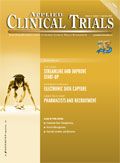The Shift to a Centralized Lab Approach
Central labs promote scientifically objective results, through independence of action on a contractual basis with the sponsor.
Testing drives drug development. From laboratory tests on patients' specimens comes almost all the clinical data needed for a new drug application. How and where those specimens are collected, transported, stored, and analyzed impacts the quality and usefulness of the data they produce. In the past, most tests were processed by local, academic, and specialized testing laboratories and coordinated by each investigator. However, centralized testing is becoming an accelerated trend—one that uses advanced technology and global operations to concentrate clinical trial tests in a single, central laboratory.
Combining for consistency
The central lab core value is consistency. When local laboratories perform testing, their results will be different. In fact, if they were not, it would be suspicious. Central laboratory testing, on the other hand, offers "combinable data," generated from the same analytic method platform to correlate and standardize results. The end product is that a result from a central laboratory is similar regardless of the facility it came from. In contrast, local laboratories use many different analytic methods, often breaking down into "low, medium, and high" between local labs. Less variation in central lab results also makes it easier for trial sponsors to assemble meaningful statistics. In the end, results from the central laboratory are easier to defend to regulatory agencies.
Standardized sample collection kits drive consistency
Sample collection kits embody the goal of central laboratory consistency. For instance, a given test may be done on serum or plasma—different specimens—and each type of specimen will yield an answer, but that answer will be different from one to the other. Local labs pick the type of specimen that works for their own analytic method. But in a global clinical trial, that local lab will still use their local analytic method—which may be an alternate specimen type with its own bias. The central lab standardized specimen collection kit avoids such bias. The kit also contains every useful article necessary to obtain specimens and ship them back to the central lab. Thus, the standardized kit removes many possible variables from the specimen collection environment. In each kit, the set of collection components are specific to a particular patient visit—from screening at the first visit, through all other visits for the remainder of the trial. Special kits apply for retests, end-of-trial activities, anatomic pathology specimens, PK, biomarkers, and genomics. This standardization promotes another basic—and productive—central laboratory solution to specimen collection: recognition of the expertise of the investigator and staff who do the actual collection of the specimens. Collection methods and instructions can be optimized, training investigator staff in efficient specimen handling so the trial can begin enrollment with minimum delay, reach budget milestones, and deliver required data by meeting the unique needs and timelines of each protocol.
Oncology data: shifting from local
In recent years, we see a shift from local laboratories to centralized analysis in the support of oncology studies. Three main forces determine the pace of further progress: international regulatory harmonization of drug development, growth of global trials, and progress of cancer research. Key trends include increased analysis of "biomarkers" and greater regulatory pressure for global data combinability. The pace of adoption of central laboratory services in oncology trials depends greatly on the direction cancer research takes in the next few years. For pathologists, tumor heterogeneity—variability of a malignancy within itself—is increasingly recognized, and promises to complicate oncology for years to come. Central laboratories assist or improve the clinical trial process for oncology studies in several ways:
- Globally uniform sample collection kits, customized to each trial and paired with logistics support services, to ensure irreplaceable tissue biopsies arrive at the laboratories in optimum time and condition.
- Specimen management services to allocate and track patient tissue block samples through each step, regardless of sectioning type or placement on slides or in tubes.
- "Target enrichment" of anatomical specimens, to yield concentrated tumor tissue for use in downstream genetic and molecular testing, allied with digital imaging and special processing techniques.
Trends favor central lab model
But industry resistance to the central model persists. One traditional argument for the use of local laboratories is patient safety and dosing—but the central lab's means and speed of reporting results improves constantly, and this actually enhances patient safety, while keeping consistency in analysis around the world. It's the best of both worlds.
Finally, use of central labs holds out to sponsors something no local lab can. Time and again newspaper headlines trumpet irregularities traceable to individual persons whose scientific detachment was lost, whether for economic, personal, or sinister reasons. Central labs promote scientifically objective results, through independence of action on a contractual basis with the sponsor, transparency via a durable audit trail, and by being responsible to governmental regulatory bodies through licensing and certification. These conditions work to remove bias due to local pressure, whether cultural, economic, medical, political, or scientific. Thus, scientific objectivity in clinical trials results carries its own value by active work to avoid the accusation of and exposure to improper influence. The importance of this is self-evident, because in this industry the ultimate beneficiary of scientific objectivity is us.
John A. Laczin, MD, FCAP, is a physician and pathologist, boarded in both Anatomic and Clinical Pathology and the Director, Medical Affairs in Central Laboratory Services at Covance Inc., 8211 SciCor Drive, Indianapolis, IN, e-mail: [email protected].

Putting Collective Insights Into Action to Advance Cancer Care: Key Examples From ASCO 2025
June 27th 2025At ASCO 2025, clinical operations leaders gained critical insights into how AI tools, bispecific antibodies, and evolving treatment paradigms are reshaping trial design, endpoint selection, and patient stratification.